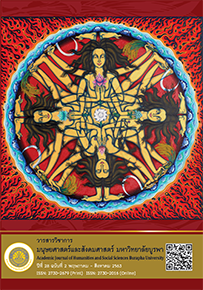รูปแบบการดำเนินชีวิตของคนรุ่นใหม่ในสังคมชนบทไทย ภาคเหนือและภาคตะวันออกเฉียงเหนือ: กรณีศึกษาพื้นที่การเรียนรู้ด้วยการบริการสังคมของบัณฑิตอาสาสมัคร มหาวิทยาลัยธรรมศาสตร์
Main Article Content
บทคัดย่อ
การวิจัยครั้งนี้มีวัตถุประสงค์เพื่อศึกษารูปแบบการดำเนินชีวิตของคนรุ่นใหม่ในสังคมชนบทไทยภาคเหนือและภาคตะวันออกเฉียงเหนือ เป็นการวิจัยเชิงปริมาณเก็บรวบรวมข้อมูลโดยใช้แบบสอบถาม จากกลุ่มตัวอย่างเจเนอเรชั่นวาย (อายุ 18 ถึง 37 ปี ณ พ.ศ. 2561) จำนวน 383 ราย ที่อาศัยอยู่ในเขตชนบทของประเทศไทยซึ่งเป็นพื้นที่การเรียนรู้ด้วยการบริการสังคมของบัณฑิตอาสาสมัคร มหาวิทยาลัยธรรมศาสตร์ สถิติที่ใช้ในการวิเคราะห์ข้อมูล ประกอบด้วย สถิติเชิงพรรณนาและการวิเคราะห์ปัจจัยโดยใช้วิธีการวิเคราะห์องค์ประกอบหลัก ผลการศึกษาพบว่า รูปแบบการดำเนินชีวิตของกลุ่มตัวอย่าง พิจารณาได้ใน 3 มิติ คือ 1) ด้านกิจกรรม สามารถจัดกลุ่มองค์ประกอบได้ 10 กลุ่ม โดย 3 ลำดับแรก ได้แก่ กลุ่มนักสืบสานประเพณีและศาสนา กลุ่มนักบริโภคสมัยใหม่ และกลุ่มนักกิจกรรมเพื่อชุมชนและอาสาสมัคร 2) ด้านความสนใจ สามารถจัดกลุ่มองค์ประกอบได้ 10 กลุ่ม โดย 3 ลำดับแรก ได้แก่ กลุ่มปฏิสัมพันธ์ดีกับเพื่อนบ้านและชุมชน กลุ่มบริโภคนิยมและเกาะกระแสแฟชั่น และกลุ่มใส่ใจภาพลักษณ์และดูแลสุขภาพ 3) ด้านความคิดเห็น สามารถจัดกลุ่มองค์ประกอบได้ 9 กลุ่ม โดย 3 ลำดับแรก ได้แก่ กลุ่มรอบรู้เรื่องสังคมและมีทัศนคติเชิงบวกต่อการดำเนินชีวิต กลุ่มเคารพกติกาสังคมและไม่ปรารถนาความขัดแย้ง และกลุ่มมุ่งตามกระแสแต่มองโลกตามความเป็นจริง
Downloads
Article Details
บทความทุกบทความเป็นลิขสิทธิ์ของวารสารวิชาการมนุษยศาสตร์และสังคมศาสตร์ มหาวิทยาลัยบูรพาเท่านั้น
เอกสารอ้างอิง
กนกพร รัตนสุธีระกุล. (2557). การเปลี่ยนแปลงวิถีการผลิตของสังคมชาวนาลุ่มน้ำชี กรณีศึกษา: บ้านหนองผือ ต.หนองบัว อ.โกสุมพิสัย จ.มหาสารคาม. วิทยาสารเกษตรศาสตร์สาขาสังคมศาสตร์, 35(3), 447-459.
กฤษณพจน์ ศรีทารัง, ชมภูนาฏ ชมพูพันธ์ และสรินทร คุ้มเขต. (2558). ชาวลัวะบ้านหมันขาว: การปรับตัวและแนวโน้มการเปลี่ยนแปลง. วารสารวิจัยและพัฒนามหาวิทยาราชภัฏ เลย, 10(33), 86-94.
คมกริช นันทะโรจพงศ์, ภูธิป มีถาวรกุล และประสพชัย พสุนนท์. (2561). พฤติกรรมการเป็นผู้ประกอบการของวัยรุ่นไทย: ตัวแปรสาเหตุที่ส่งผลต่อตัวแปรพฤติกรรมการเป็นผู้ประกอบการของวัยรุ่น. วารสารบริหารธุรกิจศรีนครินทรวิโรฒ, 9(2), 44-59.
ชาย โพธิสิตา. (2555). ชนบทไทยในวิถีทุนนิยม. วารสารราชบัณฑิตยสถาน, 37(4), 163-185.
เชิดชัย หมื่นภักดี. (2559). การเปลี่ยนภูมิทัศน์ทางเศรษฐกิจและสังคมของชาวนาอีสานในจังหวัดบึงกาฬ. วิทยานิพนธ์ปรัชญาดุษฎีบัณฑิต, สาขาวิชาสหวิทยาการ, วิทยาลัยสหวิทยาการ, มหาวิทยาลัยธรรมศาสตร์.
นภาพร อติวานิชยพงศ์. (2557). คนชนบทอีสานกับการทำมาหากิน: ความเปลี่ยนแปลงตามยุคสมัย. วารสารสังคมวิทยามานุษยวิทยา, 33(2), 103-127.
นภาพร อติวานิชยพงศ์, กนกวรรณ ระลึก และกนกวรรณ แซ่จัง. (2557). ชุดโครงการวิจัย ชนบทไทยในมุมมองบัณฑิตอาสาสมัคร: บทสังเคราะห์องค์ความรู้จากงานศึกษาของบัณฑิตอาสาสมัครมหาวิทยาลัยธรรมศาสตร์. กรุงเทพฯ: วิทยาลัยพัฒนศาสตร์ป๋วย อึ๊งภากรณ์ มหาวิทยาลัยธรรมศาสตร์.
ปิยวัฒน์ เกตุวงศา, ศุทธิดา ชวนวัน และวิชาญ ชูรัตน์. (2559). รายงานวิจัยฉบับสมบูรณ์ โครงการความอยู่ดี มีสุขของครัวเรือนชนบทไทยภายใต้การเปลี่ยนแปลงทางประชากรและสังคม. กรุงเทพฯ: สำนักงานกองทุนสนับสนุนการวิจัยและต้นสังกัด.
พระมงคล สุมงฺคโล. (2560). ศึกษาการเปลี่ยนแปลงทางสังคมที่มีต่อวิถีชีวิตชนเผ่าละว้า หมู่ที่ 11 ตำบลป่าแป๋ อำเภอแม่สะเรียง จังหวัดแม่ฮ่องสอน. วารสารพุทธศาสตร์ศึกษา, 8(2), 57-68.
วสันต์ ปวนปันวงศ์. (2560). การพัฒนาพื้นที่ชนบทให้กลายเป็นเมือง กรณีศึกษาแหล่งท่องเที่ยวดอยม่อนแจ่ม อำเภอแม่ริม จังหวัดเชียงใหม่. วารสารรัฐศาสตร์และรัฐประศาสนศาสตร์, 8(2), 55-80.
สุนิตย์ เหมนิล และณัฐศิริ พงศาวลี. (2561). ตลาดชุมชนในสังคมกึ่งชนบท: วิถีการทำมาหากินของคนอีสาน กรณีศึกษาจังหวัดอุดรธานี. วารสารพื้นถิ่นโขง ชี มูล, 4(2), 181-216.
สุระเดช ไชยตอกเกี้ย. (2558). รายงานวิจัยเรื่อง ปัจจัยที่มีผลต่อพฤติกรรมการบริโภคอาหารของวัยผู้ใหญ่ ภาคตะวันออกเฉียงเหนือ. กรุงเทพฯ: สำนักงานกองทุนสนับสนุนการสร้างเสริมสุขภาพ (สสส.) และสำนักงานพัฒนานโยบายสุขภาพระหว่างประเทศ (IHPP).
อรรถจักร์ สัตยานุรักษ์. (2553). เสวนาที่เชียงใหม่: โฉมหน้าใหม่ของสังคมชนบทภาคเหนือ. เข้าถึงได้จาก https://prachatai.com/journal/2010/08/30596
อรรถจักร สัตยานุรักษ์. (2559). การกลายเป็นเมืองในชนบทไทย: ข้อสังเกตและข้อเสนอแนะ. เข้าถึงได้จาก https://www.slideshare.net/FURD_RSU/ss-58359405
Dickey, J., & Sullivan, J. (2007). Generation shift in media habits. Media Week, 17(7), 10.
Hair, F. J., Black, C. W., Babin, J. B., & Anderson, E. R. (2006). Multivariate data analysis. (6th ed.). Upper Saddle River, NJ: Pearson Prentice Hall.
Meier, J., Austin, S., & Corcker, M. (2010). Generation Y in the workforce: Managerial challenges. The Journal of Human Resource and Adult Learning, 6(1), 68-78.
Plummer, J. T. (1974). The concept and application of life style segmentation. Journal of Marketing, 38(1), 33-37.
Solomon, M. R. (2015). Customer behavior: Market survey (11th ed.). Boston: Pearson.
Van den Bergh, J., & Behrer, M. (2011). How cool brands stay hot: Branding to generation Y. Great Britain: Kogan Page.
Van Meter, R. A., Grisaffe, D. B. G., Chonko, L. B., & Roberts, J. A. (2012). Generation Y’s ethical ideology and its potential workplace implications. Journal of Business Ethics, 117(1), 93-109.
Williams, K. C., & Page, R. A. (2011). Marketing to generations. Journal of Behavioral Studies in Business, 3(3), 1-17.
Yamane, T. (1967). Statistics, an introductory analysis (2nd ed.). New York: Harper and Row.


